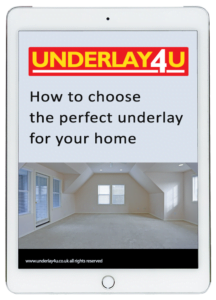If you’re thinking of laying laminate flooring yourself, a bit of planning will go a long way especially if you need to remove laminate floor first.
For example, where do you want it to go – which room(s)? Do you want the room to look wider or longer? Will you have a floating, glued or nailed floor?
In this post, we will address the key questions related to planning, removing, buying and fitting your laminate flooring.
We also give advice on which laminate underlay you will need.
But first, here’s how to plan the look of your floor in different rooms.
Laying Laminate in the kitchen or lounge
There are things to be aware of when laying laminate in the kitchen.
Firstly, do you use the kitchen as an in-out room to the garden – i.e. is your back door leading straight into the kitchen?
If that’s the case, then you probably want to choose a dark coloured floor. That way, you won’t see all the marks as the family are traipsing dirt in and out.
In fact, if this is the case, you might want to think carefully about whether you purchase more durable flooring based on how much it is used.
If you’re looking to lay it around a kitchen island, remember you will need an expansion gap all round the edge. Also, you should never fit an island on top of a floating floor. This is discussed in more detail below.
Further, how much light do you have in the kitchen or lounge? If your windows are at the end of the room, you should probably lay your flooring long-ways so that it reflects the light. Alternatively, if you want to mkae a small room look bigger, try width-ways across the room rather than along the room – most people go for long-ways.
Placing your new floor in the lounge or kitchen may pose a different set of questions. For example, do you want an added cosiness in the form of underfloor heating?
Also, do you have heavy furniture that will need to be placed on top? If so, your installation methods may need to be addressed, also explained in more detail later in this article.
Best Underlay for Laminate
Depending on your choices above there are a few options as to which underlay is best. We have a full article on this called What is the best underlay for laminate flooring?
Laminate Underlay with Damp Proof Membrane (DPM) is the most popular choice. Even if your room has a low moisture level, you can still choose a product with a DPM. Alternatively, if you are fitting underfloor heating, you will need a special type of underlay. For example, the Duralay Heatflow.
How to Remove laminate flooring
It’s important to remember that it will be much easier if you don’t want to reuse your old laminate floor once it has been removed.
However, if you are really keen to save it then you need to be super careful when removing the old planks. You might also want to make sure you can still purchase the same style from a place near you or online so that if you do lose some pieces, you can still fit a full room when you decide to use it again.
With that said, simply start by removing any transition pieces that are fitted between rooms. A transition piece usually lays between two different types of floor where the doors are fitted.
Great, now you need to check if there is any beading around the outside of the room.
Carefully remove it from the wall (or skirting) behind it. Once removed, pull the nails out from the back of the beading so you don’t ruin the front of the piece. If you want to reuse the beading, be sure to make a note of where in the room each piece was fitted.
Then, start at the side of the room, where you removed the threshold, and pull up the whole row.
Then, tilt upwards and pull away from you to unhook the row of boards from the spline that it’s connected to. You might want to use the back of a hammer or a even a specialised pull bar to make the job slightly easier – but again, be very careful if you want to save the pieces for another use.
Once you have the first row out, you should be able to remove the next rows quite nicely.
A couple of more things:
- If you want to reuse, be careful not to walk on the splines (the thin edge of each plank)
- Save your knees by wearing knee-pads while you’re kneeling on the hard floor for long periods.
Essential Steps & Tips when Laying & Installing Laminate Flooring Yourself
If you want to do the job yourself, these are the steps to take so you can be sure to achieve installation success:
- Acclimatise your flooring prior to installation
Don’t remove your old stuff until you have acclimatised the new to your normal living conditions. In order to acclimatise your new flooring, Remove planks from the box and stack them up in a stick-a-stak style i.e. 2 down and 2 across each other. mix up the pieces from different boxes to create natural colour variation when they are laid. Acclimate for 5 days.
Image courtesy of suttontimber.co.uk – Acclimatise Laminate Flooring when Laying
2. Clean, dry and level out the sub floor
Once you have removed your old stuff, you will need to make sure the sub floor is ready for laying. Simply wipe, clean and ensure it is level before putting any underlay down.
3. Ensure it’s structurally sound and Fix excessive moisture
If you have structural issues with your building, it could increase the amount of moisture that is let in through your home. Especially during the winter months. Therefore, make sure you are happy with the look and feel of the structure before fitting a brand new purchase. If you do have concerns, contact your local tradesman.
One option to ensure the sub floor use a moisture meter on the sub floor – use an underlay with a damp proof membrane
4. Fit your laminate floor
Keep an expansion space of approximately a 10mm gap around all fixed objects such as walls, skirting boards and door frames. This will allow the new wood to expand and contract as the weather and temperature changes throughout the year.
If you don’t want to fit beading, afterwards, you may need to undercut the skirting boards and door frames to allow for appropriate floor movement and a nice finish. Remember to allow for underlay. Cutting the skirting boards is an experts job though, so probably best not to try this yourself.
There’s a good chance that your room isn’t exactly the same width as the last row, so you will need to cut the last row of boards to fit the remaining gap.
Start your first full plank at one corner of the room and work longways. Then once you have your first row in place, start fitting the next row and continue to work across the room. If you are fitting yourself, it is a good idea to look for click-system fitting planks. That way they should slot simply into place.
There’s more below on the considerations to bear in mind, when making the decision on fitting method.
4. Maintain Climate after fitting
After acclimation and after fitting, keep the home at a consistent temperature and moisture level, where possible. If you have climate control in the home, keep it on even if you go on holiday as it will keep conditions consistent.
Installation considerations
You will need to decide how you want to install your laminate. Here are some of the pros and cons with eachown pros and cons.
Floating Floor
A floating, click-system are often the easiest and least labour intensive to fix in place.
Benefits of a floating floor – it can be installed over any sub floor, underlayments can be used, it’s easy to install and remove e.g. click/lock, can be walked on immediately and furniture can be returned to it’s original position immediately
Tips – Use transition pieces between rooms, don’t install cabinets on top and don’t put heavy objects over 200 kg
A Glue Fitted Floor
Benefits for a glued floor – installs over concrete and ply wood, floors can flow between rooms (without transition pieces), supports heavy objects over 200 kilo
Tips – only use special adhesive that is compatible with moisture barrier.
A nail-down Floor
Benefits of a nail-down floor – very fast to install, supports heavy objects over 200 kilo, furniture can return immediately
Nail down tips – staples will not work.
So these are our tips when setting out to fit laminate floor yourself. If you have any questions, please let us know in the comments below.





